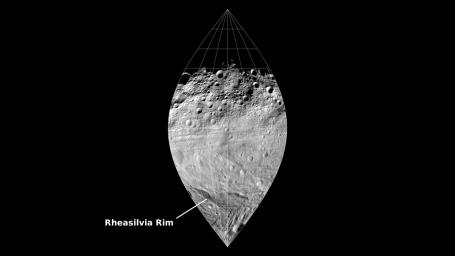Slice of Vesta
Caption:
This image mosaic from NASA's Dawn mission shows a slice of the surface of the giant asteroid Vesta. This mosaic, which covers one quarter of Vesta's surface, shows the pronounced difference between the northern and southern hemispheres. The south was strongly influenced by the recent formation of the Rheasilvia impact basin about 1 billion years ago. The south has relatively few craters and sharp, fresh topography. The more ancient north is more heavily cratered and the topography is more eroded. A set of troughs circling the equator is also visible. The impact that created Rheasilvia is likely responsible for creating the troughs.
The data were taken by Dawn's framing camera during the high-altitude mapping orbit, which averaged about 420 miles (680 kilometers) in altitude and took place from Sept. 30 to Nov. 2, 2011. The approximate resolution of the images is about 200 feet (60 meters) per pixel.
Background Info:
The Dawn mission to Vesta and Ceres is managed by NASA's Jet Propulsion Laboratory, a division of the California Institute of Technology in Pasadena, for NASA's Science Mission Directorate, Washington. UCLA is responsible for overall Dawn mission science. The Dawn framing cameras were developed and built under the leadership of the Max Planck Institute for Solar System Research, Katlenburg-Lindau, Germany, with significant contributions by DLR German Aerospace Center, Institute of Planetary Research, Berlin, and in coordination with the Institute of Computer and Communication Network Engineering, Braunschweig. The framing camera project is funded by the Max Planck Society, DLR and NASA/JPL.
More information about Dawn is online at
http://www.nasa.gov/dawn
and
http://dawn.jpl.nasa.gov
.
Cataloging Keywords:
| Name |
Value |
Additional Values |
| Target |
4 Vesta |
|
| System |
Main Belt |
|
| Target Type |
Asteroid |
|
| Mission |
Dawn |
|
| Instrument Host |
Dawn |
|
| Host Type |
Orbiter |
|
| Instrument |
Framing Camera (FC) |
|
| Detector |
|
|
| Extra Keywords |
Crater, Grayscale, Impact |
| Acquisition Date |
|
| Release Date |
2012-05-10 |
| Date in Caption |
2011-11-02 |
|
| Image Credit |
NASA/JPL-Caltech/UCLA/MPS/DLR/IDA |
| Source |
photojournal.jpl.nasa.gov/catalog/PIA15666 |
| Identifier |
PIA15666 |

 Planetary Data System
Planetary Data System
